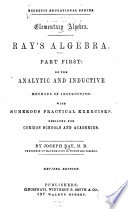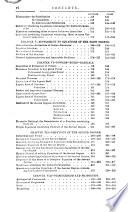 | Herbert Edwin Hawkes, William Arthur Luby, Frank Charles Touton - Algebra - 1926 - 456 pages
...+ 2 ab + b". This may be expressed in words as follows : (lil The square of the sum of two terms is the square of the first term plus twice the product of the two terms plus the square of the second term. Similarly, (a - b)2 = a2 - 2 ab + ba, which may be expressed... | |
 | William Raymond Longley, Harry Brooks Marsh - Algebra - 1926 - 608 pages
...bУ = a2 + 2 ab + b2. This rule may be stated as follows : Rule. The square of the sum of two terms is equal to the square of the first term, plus twice the product of the two terms, plus the square of the second term. Example. (4 x2 + 3 ?/)2 = 16 x4 + 24 x2y3 + 9 г/6.... | |
 | Harl Roy Douglass - Education, Secondary - 1926 - 582 pages
...be representative and typical. Just how many cases are necessary to teach a class inductively that " the square of a binomial is equal to the square of the first, plus the square of the second, plus or minus (depending upon the agreement of signs of the terms of... | |
 | Charles Davies - Algebra - 1891 - 312 pages
...The law by which these squares are formed can be enumerated thus : — The square of any polynomial is equal to the square of the first term, plus twice...term by the second, plus the square of the second; plus twice the sum of the first two terms multiplied by the third, plus the square of the third ; plus... | |
 | Joseph Ray - Algebra - 1848 - 248 pages
...q (4.) Hence, every complete equation of the second degree, may be reduced to the form x2+2px=q, in which 2p and q may be either positive or negative,...second, plus the square of the second ; if we consider x2+2px as the first two terms of the square of a binomial, it'2 is the square of the first term (z),... | |
 | Joseph Ray - Algebra - 1848 - 252 pages
...the square of any polynomial is formed according to the following law: The square of any polynomial is equal to the square of the first term— plus twice the first term, plus the second, multiplied by the second — plus twice the first and second terms, plus... | |
 | Joseph Ray - Algebra - 1848 - 260 pages
...the square of any polynomial is formed according to the following law: The square of any polynomial is equal to the square of the first term — -plus twice the first term, plus the second, multiplied by the second — plus twice the first and second terms, plus... | |
| |